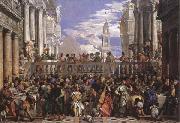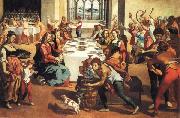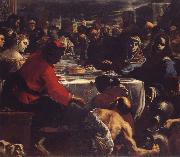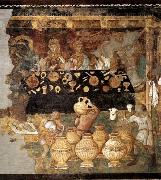
|
Paolo Veronese
|
|||
|
|
|||
| Italian Mannerist Painter, ca.1528-1588 Italian painter and draughtsman. With Titian and Tintoretto he makes up the triumvirate of great painters of the late Renaissance in Venice. He is known as a supreme colourist and for his illusionistic decorations in both fresco and oil. His large paintings of biblical feasts executed for the refectories of monasteries in Venice and Verona are especially celebrated. He also produced many altarpieces, history and mythological paintings and portraits. His compositional sketches in pen, ink and wash, figure studies in chalk, and chiaroscuro modelli and ricordi form a significant body of drawings. | |||
|
|
|||
|
The Marriage at Cana new2/Paolo Veronese-562424.jpg Painting ID:: 26750 |
Oil on canvas 6.7x9.9cm Louvre,Paris | ||
|
|
|||
|
Andrea Boscoli
|
|||
|
|
|||
| Italian, ca.1560-1607 | |||
|
|
|||
|
The Marriage at Cana new3/Andrea Boscoli-225743.jpg Painting ID:: 28982 |
mk65 Oil on canvas 50 3/16x72 3/16in Uffizi,Gallery | ||
|
|
|||
|
Mattia Preti
|
|||
|
|
|||
| 1613-1699 Italian Mattia Preti Gallery Born in the small town of Taverna in Calabria, Preti was sometimes called Il Cavalier Calabrese (the Knight of Calabria). His early apprenticeship is said to have been with the "Caravaggist" Giovanni Battista Caracciolo, which may account for his life-long interest in the style of Caravaggio. Probably before 1630, Preti joined his brother Gregorio (also a painter), in Rome, where he became familiar with the techniques of Caravaggio and his school as well as with the work of Guercino, Rubens, Reni, Giovanni Lanfranco. In Rome, he painted fresco cycles in Sant'Andrea della Valle and San Carlo ai Catinari. Between 1644 and 1646, he may have spent time in Venice, but remained based in Rome until 1653, returning later in 1660-61. He painted frescoes for the church of San Biago at Modena (app. 1651-2) and participated in the fresco decoration of the Palazzo Pamphilj in Valmontone (documented 1660-61), where he worked along with Pier Francesco Mola, Gaspar Dughet, Francesco Cozza, Giovanni Battista Tassi (il Cortonese), and Guglielmo Cortese. Jacob blessing his grandchildren, Ephraim and Manasseh, in the presence Joseph and their mother Asenath. Whitfield Fine Art Gallery, London.During most of 1653-1660, he worked in Naples, where he was influenced by the other major Neapolitan painter of his era, Luca Giordano. One of Preti's masterpieces were a series of large frescoes, ex-votos of the plague (which were painted on seven city gates but have since been lost to the ravages of time), depicting the Virgin or saints delivering people from the plague. Two sketches are in the Capodimonte Museum in Naples. The bozzetto of the Virgin with the baby Jesus looming over the dying and their burial parties envisions a Last Judgement presided over by a woman. Preti's salary for the work was 1500 ducats. Preti also won a commission to supervise the construction, carving, and gilding for the nave and transept of San Pietro a Maiella. Having been made a Knight of Grace in the Order of St John, he visited the order??s headquarters in Malta in 1659 and spent most of the remainder of his life there. Preti transformed the interior of St. John's Co-Cathedral in Valletta, with a huge series of paintings on the life and martyrdom of St. John the Baptist (1661-1666). In Malta one also can find many paintings of Preti in private collections and in parish churches. His increased reputation led to an expanded circle of patrons, and he received commissions from all over Europe. Preti was fortunate to enjoy a long career and have a considerable artistic output. His paintings, representative of the exuberant late Baroque style, are held by many great museums, including important collections in Naples, Valletta, and in his hometown of Taverna. | |||
|
|
|||
|
The Marriage at Cana new16/Mattia Preti-468377.jpg Painting ID:: 43100 |
mk170 1655-1660 Oil on canvas 203.2x226cm | ||
|
|
|||
|
MASTER of the Catholic Kings
|
|||
|
|
|||
| Spanish painter active 1485-1500 in Castilia | |||
|
|
|||
|
The Marriage at Cana new16/MASTER of the Catholic Kings-845865.jpg Painting ID:: 43544 |
c. 1495/1497 Oil on panel, 137,1 x 92,7 cm | ||
|
|
|||
|
Jacopo Torriti
|
|||
|
|
|||
| Italian painter, Roman school active c. 1270-1300, Italian painter and mosaicist. Two mosaics in Rome are signed by him: one, on the apse of S Giovanni in Laterano, that once bore the date 1291 (or, according to some sources, 1290 or 1292); and another on the apse and triumphal arch of S Maria Maggiore, now replaced by a 19th-century restoration but at one time dated 1295 or 1296. Torriti is also known to have executed a mosaic for Arnolfo di Cambio's tomb of Pope Boniface VIII (1296; destr.; see ARNOLFO DI CAMBIO) in Old St Peter's, Rome. Torriti was active during the same period as Cimabue and Giotto, Pietro Cavallini and Arnolfo di Cambio, but his fame has been obscured by theirs, no doubt because of his closer links with Byzantine art. He was nevertheless one of the most important artists working in Rome during the papacy of Nicholas IV (1288-92) and was entrusted with some of the most prestigious commissions of the day. | |||
|
|
|||
|
The Marriage at Cana new16/Jacopo Torriti-554425.jpg Painting ID:: 44314 |
Oil on canvas | ||
|
|
|||
|
Also Buy::. For Following Paintings / Artists / Products, Please Use Our Search Online: |












